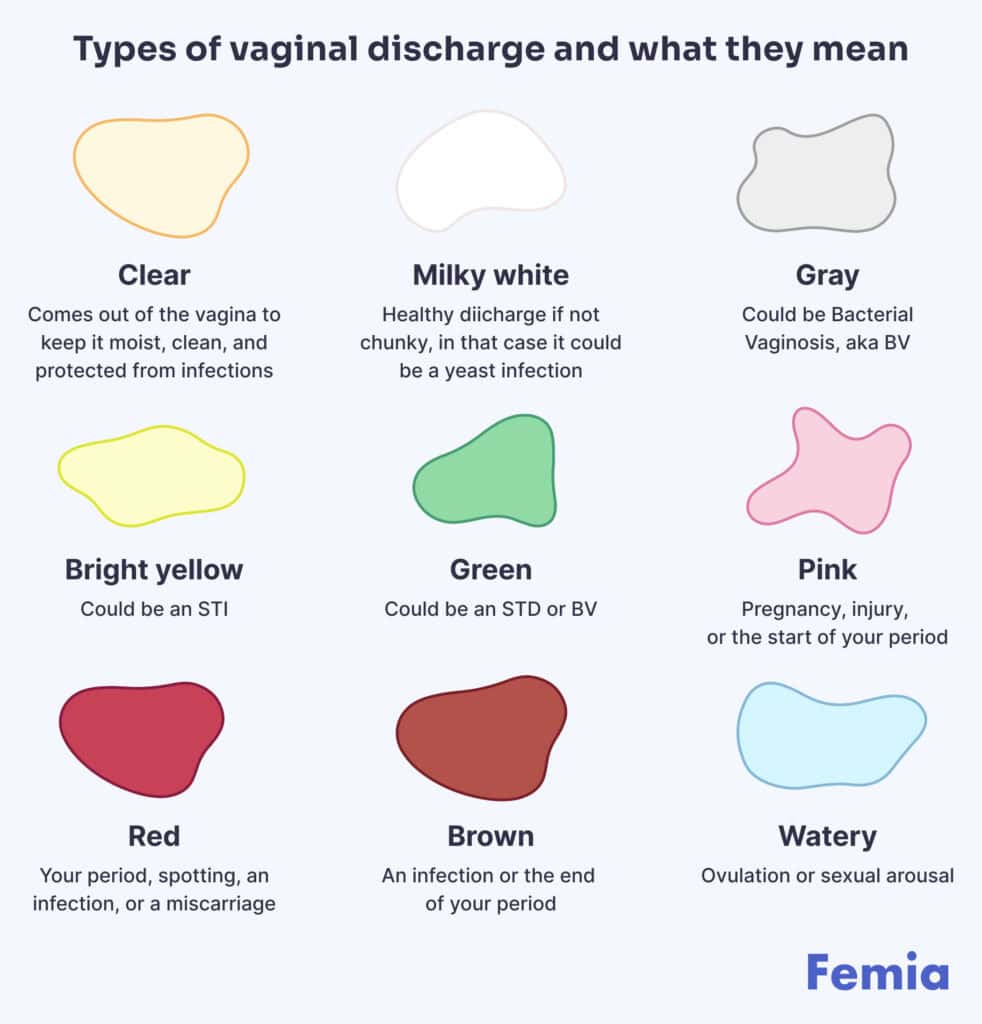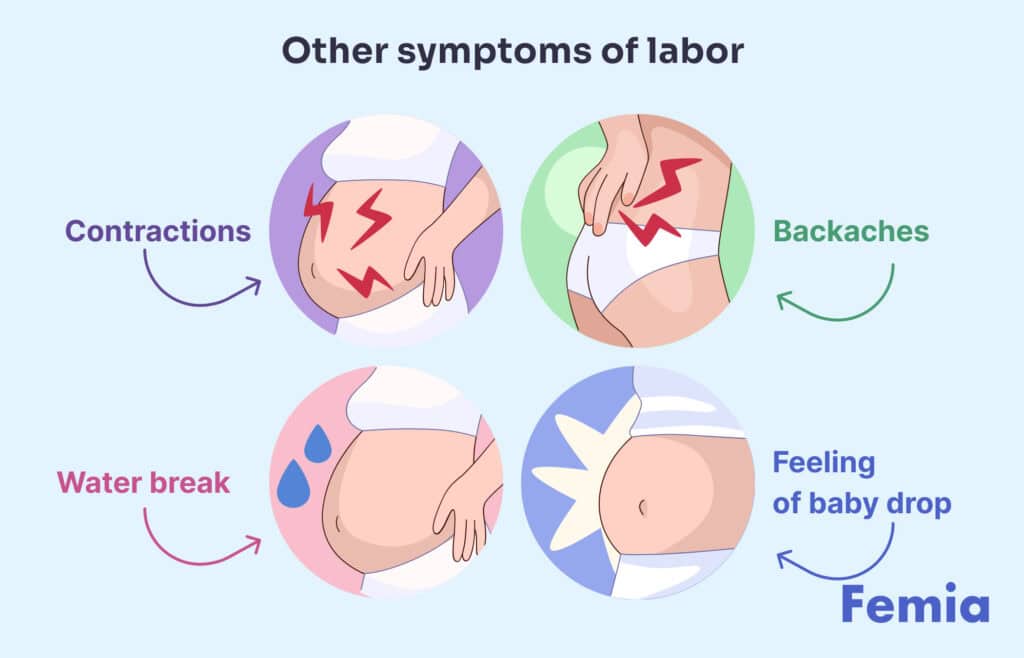Femia > Health Library > Pregnancy > Pregnancy health > Mucus plug vs. discharge: Understanding the differences
Mucus plug vs. discharge: Understanding the differences

- Updated Mar 2, 2025
- Published
CRAFTED BY HUMAN
Crafted by human At Femia, we provide accurate and up-to-date information at every stage of your journey, from trying to conceive, pregnancy and postnatal support. All content is created by a real person based on in-depth research and own professional experience. Femia ensures that you will receive expert advice, strict accuracy and a personalized approach from our authors/medical experts. Learn more about our editorial policy.
FACT CHECKED
Fact checked At Femia Health, we maintain the highest standards of editorial excellence in delivering content focused on helping you conceive, guiding you through pregnancy, and supporting you postpartum. Explore our content review principles to learn how we ensure the accuracy and quality of our health and lifestyle tips for every stage of your journey.
- The mucus plug is a thick, jelly-like substance, often clear to pinkish-brown, that appears late in pregnancy as labor approaches.
- Regular discharge is thinner, milky or clear, and occurs throughout pregnancy.
- While losing the mucus plug can signal upcoming labor, it’s not always immediate.
Are you facing difficulty differentiating between a mucus plug vs discharge? There is no need to worry; that’s a typical concern in pregnant women. But, it is pretty easy to identify them once you know the key differences and timings! The color, appearance, and consistency can help you differentiate between them.
Above all, identifying a mucus plug and discharge can help you track your pregnancy and let you feel more informed, confident, and calm about your bodily changes. It will also help you analyze your body’s secretions, so you can consult your healthcare provider in case of any abnormal discharge.

What is a mucus plug?
The mucus plug is a thick, sticky, jelly-like substance that may be clear or slightly pinkish-brown. It forms a protective covering around the opening of the cervix—the narrow canal that connects the uterus to the vagina—during pregnancy.

The purpose of a mucus plug is to form a protective coating around the cervix and block the entry of foreign particles into the uterus that may cause infections and harm the fetus.
During the last stages of pregnancy or when the labor is near, the mucus plug begins to loosen, break, and release from the vagina in the form of thick, jelly-like discharge, with or without blood.
The release of a mucus plug typically occurs when your cervix dilates in preparation for childbirth, but it can also come out any time during pregnancy, which is normal. It commonly occurs near the 37th week of pregnancy and is often an early sign of labor.
What is vaginal discharge?
Your vagina is a birth canal and carries the risk of infection when exposed to foreign substances and bacteria. Vaginal discharge acts as a thick protective barrier that prevents the entry and growth of bacteria or other microorganisms.
Vaginal discharge is a clear or whitish-yellow liquid that comes out of the vagina to keep it moist, clean, and protected from infections. It also helps maintain the thickness of the vaginal lining and provides lubrication during sexual intercourse.

👉Find out more: Watery period blood: A sign of pregnancy or health issue?
During pregnancy, your body produces more estrogen hormones, which help the uterus grow and promote the development of your baby’s organs. The increased release of estrogen stimulates your mucus membranes and promotes blood flow to the pelvis, leading to more vaginal discharge.
Moreover, the volume and consistency of vaginal discharge during pregnancy may also increase to provide additional protection from vaginal and uterine infections. Vaginal discharge during pregnancy may appear as clear, milky white, or creamy thin liquid with a mild smell.
Mucus plug vs. discharge: key differences
Here are the key differences of a mucus plug vs discharge:
1. Appearance
So, what does a mucus plug look like, and how does it differ from vaginal discharge? Let’s discuss its appearance in detail.
Color. Did you know that the color of a mucus plug and discharge can vary? But what color is a mucus plug?
- The color of your mucus plug may range from off-white or clear, to slightly bloody with a brownish, reddish, or pinkish tone.
- The color of vaginal discharge is whitish-yellow, creamy, or clear, and it does not appear with blood or a reddish tone.
Texture. Vaginal discharge is thin, while a mucus plug is comparatively thicker and appears greater in quantity.
Consistency. Your mucus plug will be jelly-like, sticky, and stringy, while discharge is commonly more slippery than sticky.
2. Timing
There is no specific timing for vaginal discharge or mucus plug dislodging. It can happen throughout or at any time during your pregnancy.
The general timeline of discharge vs mucus plug is:
- Vaginal discharge, or leukorrhea, starts about one to two weeks after conception and increases and becomes more noticeable as pregnancy progresses.
- A mucus plug mostly appears after the 37th week of pregnancy or a few days before labor, but it can also loosen and release in parts any time from the midpoint of the pregnancy.
Remember, there is no precise timeline for mucus plug release, as the timings of each woman’s discharge can vary. It can depend on other factors, like hormonal changes, natural body variations, or physical activity.
So, the timeline variation is normal, and the discharge can vary from person to person.
3. Significance
Vaginal discharge is the first protective barrier that inhibits the entry or growth of microorganisms, bacteria, and other foreign particles in the vagina, maintaining a safe and moist environment in and around your vagina.
The mucus plug is the second protective barrier that doesn’t let foreign particles and bacteria reach the uterus and fetus. It forms a layer around the cervix, so if any bacteria enters the vagina, it will not reach the uterus and harm your baby.
👉Find out more: Understanding early decelerations in fetal heart rate monitoring
What is a bloody show?
A “bloody show” is the discharge or release of blood and mucus from your vagina. It’s the light bleeding that happens at the end of your pregnancy, when labor is approaching.
A bloody show occurs as your cervix dilates and gets ready for labor. It can appear with other labor symptoms, like contractions, severe abdominal pain, or cramping.
Your cervix is filled with blood vessels, and as it dilates, bleeding can occur, which is commonly mixed with the mucus plug.
The appearance and color of the bloody show can vary for each woman. It can be pink, brown, or red blood mixed with jelly-like, sticky mucus. Bloody shows can release in one go when labor starts or come out gradually at the end of pregnancy.
However, the amount of bloody show is similar to a few tablespoons of blood-streaked discharge. It does not occur as heavy bleeding. So, if you experience heavy bleeding in pregnancy, consult your healthcare provider.
👉Find out more: Implantation bleeding vs. miscarriage: Key differences explained
Symptoms of lost mucus plug
The three common symptoms of lost mucus plug include:
- A noticeable mucus release. You will notice a thicker discharge from your vagina. It may be prominent in your underwear or visible in toilet paper, and its appearance will resemble the mucus that comes out of your throat during a cold or cough.
- Pelvic pressure. As your cervix changes during mucus release, you will notice increased pelvic pressure.
- Bloody show. If you lose your mucus plug during the last trimester of your pregnancy or near your due date, you may notice blood mixed with mucus.
When do you lose your mucus plug?
When your labor is around the corner, your cervix begins to open up, thin out, and dilate, which increases pressure on your mucosal plug, causing it to break and release from the vagina. It helps make way for your baby to move down.
Losing your mucus plug is a common sign that your body is getting ready for labor. You generally lose the mucus plug around your delivery date, as labor approaches.
However, the release of mucus plugs also depends on other factors, like increased physical activity and hormonal changes, so it’s usually not a sign of emergency if it is released before your last days of pregnancy.
If you notice mucus release, it’s important to be attentive to other signs of labor, like contractions, increased pelvic pressure, lower back pain, or water break.
Is losing your mucus plug a sign of labor?
Loosening of the mucus plug may be a sign of labor, but its timing can vary for each woman, as every pregnancy is unique. Remember, this is because every woman’s body is different, so the timings and onset of certain symptoms can vary, which is completely normal.
Some women may experience mucus plug loss at the time of labor or just before, some may have mucus discharge a few days before delivery, and some may experience it a few weeks before labor.
So, there is no need to worry if you experience the mucus plug dislodging early, as it’s normal for this to occur a few months, weeks, or days before your delivery. Your body is capable of regenerating mucus.
Apart from loosening and discharge of the mucus plug from your vagina, there are other symptoms of labor, too, including:

1. Contractions
One common sign of labor is contractions. When you have contractions, you will feel a painful tightening and loosening of your stomach muscles. It can feel like severe period pain or cramps.
As your labor proceeds, the pain and contractions will increase in frequency, duration, and strength. The contractions occur to help push your baby towards the vagina.
2. Backaches
Backaches are another sign of labor that occur as a heavy, aching feeling.
3. Water break
The amniotic sac is a fluid-filled membrane that cushions and supports your baby in the uterus throughout pregnancy. During early labor, the membrane breaks, and the fluid is released from the vagina. Water breaks commonly occur at the time of labor, but they can also start beforehand.
When your water breaks, you may experience just a small amount of fluid release or a large burst from your vagina, which is a major sign of labor.
4. Feeling of baby drop
Another sign of labor is when you feel your baby move or drop down to your pelvis. Your belly’s shape may change slightly, and your stomach will feel lighter, as your baby’s head moves into the birth canal.
👉Find out more: Late decelerations during labor: What you need to know

When to contact a healthcare provider
During pregnancy, your body releases various reproductive hormones, like estrogen and progesterone. So, it’s completely normal to experience an increased amount of milky, creamy, or clear discharge with a mild smell. This type of discharge is known as leucorrhoea. It occurs due to changes in your hormonal levels during pregnancy.
However, it may be a matter of concern if you experience any sudden or abnormal change in your discharge. In that case, it is best to consult your healthcare provider for personalized advice.
For example, if you face an unpleasant smell or unusual color or texture in your discharge, or any vaginal pain that didn’t appear before, it is recommended to consult and inform your doctor.
Following are some of the unusual signs of discharge that should be addressed immediately:
- A sudden or abnormal increase in the volume of vaginal discharge.
- Pain, swelling, redness, itching, or irritation in the vagina.
- A foul-smelling, strong, and unpleasant odor in the discharge.
- An abnormal change in the color of the vaginal discharge.
- A change in the texture of the vaginal discharge.
Questions from the Femia community
Can losing the mucus plug cause pain or discomfort?
The dislodging and release of the mucus plug is almost similar to how it feels during increased vaginal discharge and is typically painless. It does not cause any noticeable discomfort. But, as every pregnancy and body is different, some women may experience mild discomfort or cramping similar to periods during mucus losing.
Can the mucus plug regenerate if lost early in pregnancy?
Yes; your body is constantly making vaginal discharge and mucus throughout pregnancy. So, if you lose some or all parts of your mucus plug during early pregnancy, your body will regenerate it and create more around the cervix. It's also normal to lose some of your mucus plug at the start of pregnancy and lose the rest later.
Is it possible not to notice the mucus plug coming out?
Your mucus plug can come out all at once or be released gradually. When it comes out gradually, it may be mixed with vaginal discharge, which makes it difficult to notice as it releases. So, it's possible not to notice the mucus plug coming out.
Can having sex change how my mucus plug looks or when it comes out?
Sexual activity can loosen and release mucus plugs, as well as cause light bleeding, but it doesn't have any significant impact on the timing of its formation.
Sexual intercourse during pregnancy may increase vaginal discharge, which can come out mixed with mucus plug and blood, affecting its overall appearance.
The bottom line
Vaginal discharge is a thin, clear or whitish-yellow fluid that releases throughout your pregnancy. On the other hand, a mucus plug is a light pink or clear, jelly-like substance that acts as a protective covering around the cervix and releases from the vagina during the later stages of pregnancy.
Some parts of the mucus plug may also come out gradually at the start or middle of pregnancy, during sexual intercourse, or during increased physical activity. The mucus plug may release with streaks of blood, making it reddish brown in colour.
Keep an eye on your vaginal discharge, so you can notice any unusual changes in secretion.
References
- Lacroix, Guillaume, et al. “The Cervicovaginal Mucus Barrier.” International Journal of Molecular Sciences, vol. 21, no. 21, Nov. 2020, p. 8266. https://doi.org/10.3390/ijms21218266.
- American Pregnancy Association. “Mucus Plug – What Is It & What Does It Look Like?” American Pregnancy Association, 30 Dec. 2022, https://americanpregnancy.org/healthy-pregnancy/labor-and-birth/mucus-plug/.
- “Vaginal Discharge in Pregnancy.” nhs.uk, 18 Apr. 2024, www.nhs.uk/pregnancy/related-conditions/common-symptoms/vaginal-discharge/#:~:text=How%20much%20discharge%20you%20have,and%20should%20not%20smell%20unpleasant.
- https://scholar.google.com/scholar?hl=en&as_sdt=0%2C5&as_ylo=2024&q=pregnancy+hormones+and+discharge+&btnG=#d=gs_qabs&t=1723026163018&u=%23p%3DNB7iCmHpWRAJ.
- “Vulvovaginitis.” Paediatrics and Child Health, vol. 20, no. 3, Mar. 2010, pp. 143–45. https://doi.org/10.1016/j.paed.2009.10.002.
- Website, Nhs. “Signs That Labour Has Begun.” nhs.uk, 24 July 2024, www.nhs.uk/pregnancy/labour-and-birth/signs-of-labour/signs-that-labour-has-begun.

Discover the parental guide to newborn cues, including how to differentiate and respond to your baby’s body language that indicates hunger, sleep, discomfort, and more.

Struggling to conceive? Common reasons such as PCOS, lifestyle factors or age might be contributing. Get insights into what you can do and when to seek medical advice.

How to know if plan B worked? This can be a nerve-wracking question. If looking for answers, here are the common signs that plan b didn’t work.

